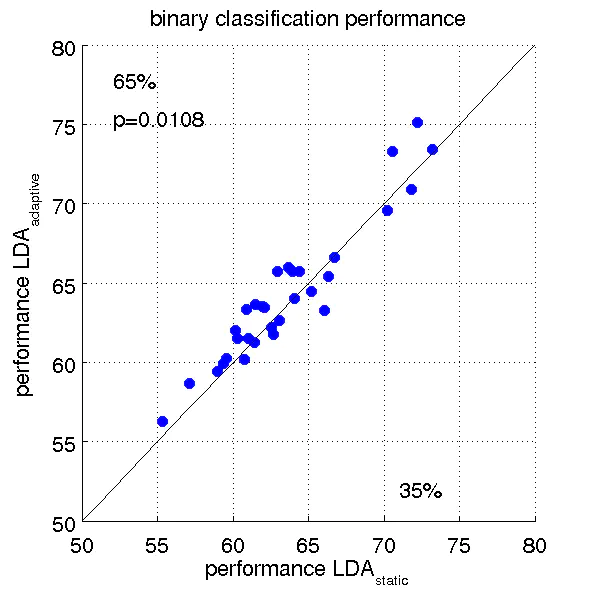Adaptation Strategies for Block-Toeplitz Regularized Linear Discriminant Analysis

While most machine learning methods make the assumption that data is i.i.d., the brain signal features collected within a brain-computer interface (BCI) experiment and even over multiple BCI sessions typically change over time. This non-stationarity is a substantial problem for a pre-trained, but otherwise fixed classification model. In patient training for rehabilitation purposes, e.g., after a stroke has induced language deficits, changes of brain signal features over time should not be considered a problem. Instead, they are desirable, as this form of non-stationarity may reflect the expected training-induced effect caused by, e.g., a more efficient use of the spared brain networks, more efficient cognitive or behavioural strategies of the patient. Recently we have shown how an auditory BCI protocol can provide a successful language training with medium to large effect size for chronic stroke patients with aphasia [1]. This BCI-based rehabilitation protocol makes use of a linear classification model to discriminate between two classes of auditory evoked responses, so-called target and non-target word-induced event-related potentials (ERPs). This system made use of a shrinkage-regularized linear discriminant analysis (sLDA) model for classification, and non-stationarity was compensated for by supervised adaptation of the class means and the covariance matrix.
[1] Musso et al. (2022). Aphasia recovery by language training using a brain–computer interface: a proof-of-concept study. Brain Communications, Volume 4, Issue 1, fcac008, https://doi.org/10.1093/braincomms/fcac008
Task
Very recent research has shown, that the performance of the sLDA can be improved by different regularization approaches, block-Toeplitz regularization with tapering of the covariance matrix [2] being one of them. As the resulting LDA classification model is capable to learn equally well also from smaller datasets, the adaption procedure should be adapted to optimize the classification performance under non-stationary conditions. This thesis investigates the computational costs of covariance updates and simulates different updating / adaptation strategies based on existing ERP-BCI data with the goal to provide an efficient adaptation strategy for future patients with aphasia who train with the BCI-based rehabilitation system.
[2] Sosulski, J., & Tangermann, M. (2022). Introducing block-Toeplitz covariance matrices to remaster linear discriminant analysis for event-related potential brain–computer interfaces. Journal of Neural Engineering, 19(6), 066001. https://doi.org/10.1088/1741-2552/ac9c98
Skills required
- Strong mathematical background and intuition, specifically on linear algebra
- Machine learning
- Good programming skills in Python (familiarity with numpy, sklearn)
- Experience in ERP data analysis (e.g., by accomplished course SOW-BKI 323 or SOW-MKI 74)